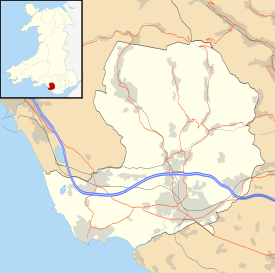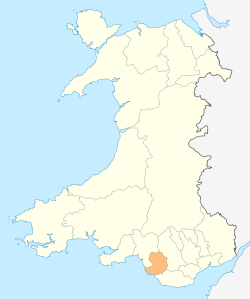Tythegston
Tythegston (Welsh: Llandudwg) is a delightful conservation area village well located (M4 J37 3 miles) close to Cardiff (24 miles) and Swansea (19 miles) on the south coast of Bridgend, Wales. It is home to the 1,200 acre Tythegston Estate, an ancient 350 year old family farming and property enterprise, with a portfolio of good quality cottages and houses to let, an industrial estate as well as hosting green energy and food production. The seaside town of Porthcawl, with its numerous beaches is within 3 miles, as is Bridgend inter-city rail station (London hourly express train c.2hrs 10mins). The village covers an area of 2,871 acres (1,162 ha). It is part of the community of Merthyr Mawr.
Tythegston
| |
|---|---|
 Tythegston Location within Bridgend | |
| OS grid reference | SS 8579 |
| Principal area | |
| Country | Wales |
| Sovereign state | United Kingdom |
| Post town | Bridgend |
| Postcode district | CF32 |
| Dialling code | 01656 |
| Police | South Wales |
| Fire | South Wales |
| Ambulance | Welsh |
| UK Parliament | |
| Senedd Cymru – Welsh Parliament |
|
History
The parish name comes from the patron saint of the village church, St Tudwg, one of the disciples of the hermit Cenydd, and is derived from its ancient Welsh appellation, Llan Dudwg, meaning "Dudwg's Town".[1] Its English name has been spelt in different ways, including Tedegestowe (13th century), Tegestowe (14th century), Dythyston (15th century), Tythegston and Tithexton (16th century). The Welsh name has been spelt as: Llandudock (15th century) and Landidwg (16th century).[2] There is evidence to suggest that a Roman villa was once constructed in or near the village. Bronze Age remains (which include a barrow and a cremation) have been found in the area.[3]
Medieval
The parish was absorbed into the territory of Newcastle with the Norman appropriation of the Glamorgan lowlands. Tythegston was constituted as a sub-manor sometime around the late 13th or early 14th century.[2] In 1870–72 the Imperial Gazetteer of England and Wales by John Marius Wilson described Tythegston as:
TYTHEGSTON, a parish, with two hamlets, in Bridgend district, Glamorgan; 4 miles W by S of Bridgend r. station. Post town, Bridgend. Acres, 2,871. Real property, £3,602. Pop. in 1851, 1,152; in 1861, 1,678. Houses, 340. The increase of pop. arose from extension of collieries, and of coke and iron works. The property is divided among a few. The living is a p. curacy, annexed to Newcastle. The church is good.[4]
Geography
Tythegston is located in the southern part of Bridgend in South Wales, 3.5 miles (5.6 km) west of Bridgend, its nearest town and lies to the north side of the A4106 road. The village covers an area of 2,871 acres (1,162 ha), of which 278 acres (113 ha) are of common land or waste.[1][2] By road Tythegston is situated 20 miles (32 km) southwest of Swansea and 23 miles (37 km) west of the capital city Cardiff. The landscape is dominated by farms and woodland such as Tythegston Church.[5]
Governance
At the national level Tythegston is in the Welsh parliamentary constituency of Bridgend, for which Madeleine Moon (Labour) has been MP since 2005.[6][7] In the general election of 2015, Moon won 14,624 votes (37.1%), giving her a majority of 1,927; the Conservative Party won 12,697 votes (32.2%) and the United Kingdom Independence Party won 5,911 (15%), while the Green Party and the Liberal Democrats each won fewer than 3,000 votes, the Green Party performed better of the two.[8] In the Welsh Assembly Tythegston is in the constituency of Bridgend for which Carwyn Jones, the First Minister of Wales, has been the Assembly Member since 1999.[9] For European elections Tythegston is in the Wales constituency.[10]
Notable landmarks
The present church, St Tudwg, is of 11th century design.[2] It was deconsecrated in around 1990. St Tudwg was converted into offices in 2010 after a four-year restoration project.[11] In the Glamorgan Archives in Cardiff a book of the registers contains baptisms from 1758, burials from 1766 and marriages starting from 1837; marriages ended until 1965, baptisms and burials to 1987.[12] Tythegston includes one Grade II building, in addition to one Grade II* building.[13]
References
- "Tremerchion – Tythegston". British History Online. 1849. pp. 405–414. Archived from the original on 17 February 2016. Retrieved 16 February 2016.
- An Inventory of the Ancient Monuments in Glamorgan: Volume III – Part 1b: Medieval Secular Monuments the Later Castles from 1217 to the present. Royal Commission on the Ancient and Historical Monuments of Wales. 2000. pp. 434–435. ISBN 978-1-871184-22-8. Archived from the original on 9 March 2016. Retrieved 16 February 2016.
- "British Archaeolgoical Sites in Tythegston". Archaeology UK. Retrieved 17 February 2016.
- "History of Tythegston, in Bridgend and Glamorgan". A Vision of Britain Through Time. University of Portsmouth. Archived from the original on 12 March 2016. Retrieved 11 March 2016.
- Maps (Map). Google Maps.
- "Election Maps". Ordnance Survey. Archived from the original on 20 February 2016. Retrieved 17 February 2016.
- "Biography". Labour Party. Archived from the original on 12 March 2016. Retrieved 17 February 2016.
- "Bridgend parliamentary consistuency – Election 2015". BBC News. Archived from the original on 14 February 2016. Retrieved 17 February 2016.
- "Carwyn Jones AM". National Assembly of Wales. Retrieved 17 February 2016.
- "MEPs by Region". European Parliament / Information Office in the United Kingdom. n.d. Archived from the original on 12 July 2013. Retrieved 25 May 2014.
- "Tythegston Church converted to offices". WalesOnline. 7 January 2010. Archived from the original on 25 February 2016. Retrieved 17 February 2016.
- "Tythegston". Genuki. Archived from the original on 12 March 2016. Retrieved 11 March 2016.
- "Listed Buildings in Merthyr Mawr, Bridgend, Wales". British Listed Buildings. Archived from the original on 15 March 2016. Retrieved 17 February 2016.
| Wikimedia Commons has media related to Tythegston. |
